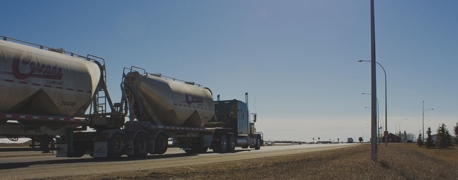What ELDT Requirements Mean for Truckers

As of last year, anyone who wants to obtain a commercial driver's license (CDL) will be required to successfully complete a specific program of instruction. This new requirement, known as the Entry-Level Driver Training (ELDT) rule, is intended to improve safety on the roads by ensuring that all CDL holders have the necessary skills and knowledge to operate their vehicles safely. The ELDT requirement will also apply to any CDL holder who wants to upgrade or expand their CDL certification, e.g. if you want to upgrade a CDL Class B to Class A. However, successful completion of an ELDT program will not be mandatory in order to renew an existing CDL. For more information on the new ELDT rule and what it means for truckers, read on.
ELDT rules require entry-level truckers to complete training under a federally compliant program, registered with the FMCSA, that incorporates both theory and behind-the-wheel instruction. These instructors are listed on the FMCSA Training Provider Registry (TPR). Drivers will be equipped with invaluable knowledge related to safe operating techniques, basic procedures such as docking or coupling, and more complex practices like skid recovery and jackknife prevention. The new ELDT requirement is a huge improvement over previous methods that mostly consisted of earning a learner's permit, minimal coursework, and a few hours out on the highway with an experienced driver in the passenger's seat. Curriculum differed by state, which led to truckers with inconsistent skillsets. By implementing these updated standards, the FMCSA makes sure that all new truckers receive the comprehensive training they need to safely hit the roads.
Lessons Taught by the I-70 Accident & Rogel Aguilera-Mederos
ELDT rules were put in place to prevent accidents like the one caused by Rogel Aguilera-Mederos in April 2019. Mederos, just 23 years old, was an inexperienced trucker who was traveling on I-70 in Colorado. Mederos' unpreparedness for the Colorado mountain passes, where even experienced truckers have difficulty, directly led to a fatal crash and his 110-year prison sentence. Mederos likely received minimal training in Texas, unaware of the potential dangers of attempting the mountainous terrain of Colorado. More rigorous instruction would have allowed Mederos to prepare for the specific problems he would face traveling through dangerous mountain passes and steep grades.
After his sentencing, trucking advocates pointed out that the real failure was the system that offered no real instruction to Mederos and drivers like him.
The ELDT rules are a pivotal step toward treating truckers like skilled professionals rather than replaceable parts. By mandating training rules at the federal level, the FMCSA is setting up a nationwide standard for drivers to be properly prepared and qualified to operate commercial vehicles. That's a positive step.
The Serious Weakness with EDLT Requirements
However, a key problem remains. In Mederos' case, a major issue was that he simply didn't have enough time behind the wheel to successfully navigate steep Colorado passes. The reason for this is simple: FMCSA standards establish no minimum hours for behind-the-wheel training. In many states, the amount of training required to get a barber's license is 1,000 hours or more. To operate clippers to cut someone's hair, a barber needs months of supervised training. To operate an 80,000-pound behemoth, a trucker only needs a couple of weeks of classroom training and a few afternoons of supervised driving.
The ELDT rules might have established a minimum amount of training before a trucker receives a CDL, but there remains a huge loophole in the CDL qualification process. CLD instruction facilities might have the most rigorous training programs ever conceived, but without a minimal standard for behind-the-wheel training, drivers might still be sent onto our highways without the experience they need to keep themselves (and us) safe.
What Happens If a New Trucker Doesn't Comply with ELDT?
With the new requirement for prospective CDL-holders to complete specialized training, truckers need to make sure they are compliant or they can face serious consequences. It is essential to be aware of recent changes and get the necessary certification from an instructor on the FMCSA's Training Provider Registry. If a trucker skips out on earning a CDL, they can expect hefty fines and possible jail time since driving without one is a misdemeanor in most states. Plus, all graduates have their records kept in a national database, so it'll be easier for employers to double-check any applicant's qualifications.
The Requirements for Registering as a CDL Instructor
Qualifications for being a CDL training instructor are more-or-less the same as most states' standards prior to the ELDT rules. The FMCSA estimate that roughly 85% of training curriculums complied with the new rules prior to February 2022. That said, some state-compliant training facilities have needed to upgrade their training programs and staff in order to meet ELDT standards.
To be an instructor for a TPR-certified training facility, an instructor must:
- Possess the same or higher class of CDL certification with appropriate endorsements (or possessed said CDL in the past)
- Have two years of on-road commercial driving experience OR two years of behind-the-wheel instruction experience
- Never had their CDL revoked, cancelled, or suspended
As trucking accident lawyers, our main concern is ensuring that truckers and other motorists are safe. The trucking industry has long been criticized for running drivers through CDL mills to get them behind the wheel as quickly as possible. This isn't good for trucking as a profession, and it's disastrous for highway safety. The ELDT rules are a step in the right direction, but until there are standardized minimums for hours of behind-the-wheel training, there's a massive gap between what CDL training is and what it could be.


